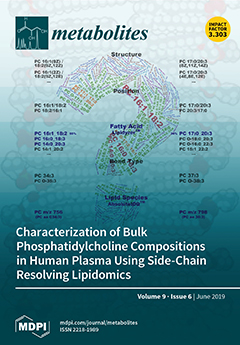The food-based empirical dietary index for hyperinsulinemia (EDIH) score assesses the insulinemic potential of diet. This cross-sectional study evaluated associations between EDIH scores from food frequency questionnaires with c-peptide concentrations and with 448 metabolites, from fasting plasma samples, in multivariable linear regression analyses.
[...] Read more.
The food-based empirical dietary index for hyperinsulinemia (EDIH) score assesses the insulinemic potential of diet. This cross-sectional study evaluated associations between EDIH scores from food frequency questionnaires with c-peptide concentrations and with 448 metabolites, from fasting plasma samples, in multivariable linear regression analyses. Metabolites were measured with liquid chromatography tandem mass spectroscopy. Using a robust two-stage study design, discovery of metabolite associations was conducted among 1109 Women’s Health Initiative (WHI) Hormone Therapy (HT) trial participants and results replicated in an independent dataset of 810 WHI Observational Study (OS) participants. In both discovery and replication datasets, statistical significance was based on the false-discovery rate adjusted
P < 0.05. In the multivariable-adjusted analyses, EDIH was significantly associated with c-peptide concentrations among 919 women (HT & OS) with c-peptide data. On average, c-peptide concentrations were 18% higher (95% CI, 6%, 32%;
P-trend < 0.0001) in EDIH quintile 5 compared to quintile 1. Twenty-six metabolites were significantly associated with EDIH in the discovery dataset, and 19 of these were replicated in the validation dataset. Nine metabolites were found to decrease in abundance with increasing EDIH scores and included: C14:0 CE, C16:1 CE, C18:1 CE, C18:3 CE, C20:3 CE, C20:5 CE, C36:1 PS plasmalogen, trigonelline, and eicosapentanoate, whereas the 10 metabolites observed to increase with increasing EDIH scores were: C18:2 SM, C36:3 DAG, C36:4 DAG-A, C51:3 TAG, C52:3 TAG, C52:4, TAG, C54:3 TAG, C54:4 TAG, C54:6 TAG, and C10:2 carnitine. Cholesteryl esters, phospholipids, acylglycerols, and acylcarnitines may constitute circulating metabolites that are associated with insulinemic dietary patterns.
Full article






